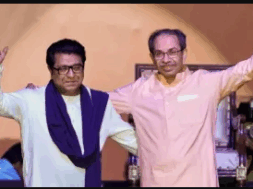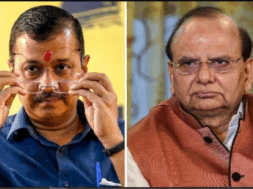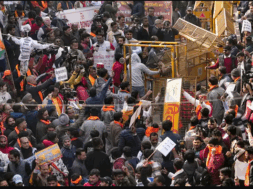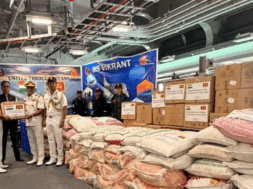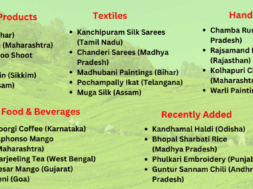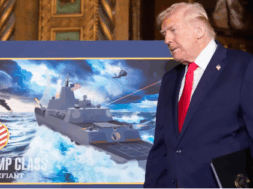
Space: NASA will train Indian astronauts for a joint mission to the ISS; the QUAD satellite mooted
Virendra Pandit
New Delhi: A day after his meeting with Indian Space Research Organization (ISRO) Chairman Dr. S. Somanath, US Ambassador to India Eric Garcetti said on Friday that the National Aeronautics and Space Administration (NASA) will soon provide advanced training to Indian astronauts to send a joint mission to the International Space Station (ISS) in the next few months.
He made these remarks while speaking at the “US-India Commercial Space Conference: Unlocking Opportunities for US & Indian Space Startups,” hosted by the US-India Business Council (USIBC) and the US Commercial Service (USCS) in Bengaluru.
“NASA will soon provide advanced training to Indian astronauts, to mount a joint effort to the International Space Station, hopefully, this year or shortly thereafter, which was one of the promises of our leaders’ visit together,” Garcetti said, the media reported on Saturday.
“And soon we will launch the NISAR satellite from ISRO’s Satish Dhawan Space Center to monitor all resources, including ecosystems, the Earth’s surface, natural hazards, sea level rise, and the cryosphere,” he said, according to a USIBC press statement issued here.
The NASA-ISRO Synthetic Aperture Radar (NISAR) is a joint Earth-observing mission between NASA and the ISRO.
“You see whether it’s the pursuit of peace and the peaceful use of space, things like the Artemis Accord, we are hand in hand, arm in arm. When it comes to prosperity and jobs, which is a big part of this conference today, it can be produced by startups in this sector, good-paying, high-tech jobs for Indians and Americans. Space is right there,” Garcetti said.
The Artemis Accords lay out a framework for collaborating nations’ safe exploration of the moon and beyond.
The day-long event in Bengaluru saw the participation of senior officials from both the US and Indian governments, including Garcetti, Dr. S Somanath, representatives from NASA, the National Oceanic and Atmospheric Administration (NOAA), and the Government of India, as well as prominent leaders from the commercial space industry, industry stakeholders, venture capitalists, and market analysts.
“I must salute the visionary leadership that we have in both, India and the US, for engaging in such an accord which looks at the Moon as a sustainable place for all of us to come and work together,” Dr. Somnath said in his remarks.
“The connection between the Indian partners and also the US partners in critical technologies and specifically in the space sector is really becoming stronger. And I’m very happy about that type of engagement and the options available to the US industries to connect with India in the emerging space sector as well,” he said.
Expressing optimism about the prospects of US-India collaboration in space, USIBC president Atul Keshap described it as a new chapter in the US-India space partnership. This week has been particularly fruitful, with USIBC and USCS joining forces to champion these two iCET space deliverables, he said.
“The conference highlights the deepening synergy between our two free nations in pioneering space exploration and innovation by the leading democracies. Through strategic alliances and collaborative efforts, we’re on the cusp of achieving extraordinary milestones and expanding the horizons of space exploration beyond what we once imagined,” Keshap said.
“The US-India Commercial Space Conference underscores the importance of fostering strategic partnerships to drive innovation and propel the space industry forward,” said USIBC Managing Director Alexander Slater.
“This is the next step in USIBC’s continued commitment to fostering bilateral cooperation among leading companies and startups from both countries to unlock new opportunities for economic growth, job creation, and technological leadership. It builds on our work in February when we hosted the second edition of INDUS-X in New Delhi, which promoted similar opportunities for innovation and cooperation in new and emerging defense technologies,” he said.
Meanwhile, senior defense officials from India and the US in Washington discussed opportunities to strengthen space cooperation and identified potential areas for collaboration with the American industry.
At a meeting for the second annual US-India Advanced Domains Defence Dialogue (AD3), they discussed a wide range of bilateral cooperation.
The American team was led by Vipin Narang, Acting Assistant Secretary of Defence for Space Policy, and the visiting Indian delegation was led by Vishwesh Negi, India’s Joint Secretary for International Cooperation.
During this year’s dialogue, Narang and Negi discussed opportunities to strengthen space cooperation and identified potential areas for collaboration with US industry, said Department of Defence Spokesperson Cmdr. Jessica Anderson.
Among a group of US and Indian defense officials, the two co-chaired the first US-India principal-level tabletop discussion that explored areas to enhance cooperation in the space domain.
They agreed to advance AD3 through regular working group discussions.
The visiting Indian Government delegation also engaged with the US Space Command, the Joint Commercial Operations Cell, and artificial intelligence experts from across the US Department of Defence, Anderson said.
Also, on Friday, Ambassador Garcetti, during his meeting with Dr. Somanath, proposed the development of a QUAD satellite in the US partnership with India, Japan, and Australia.
He visited the ISRO headquarters and concluded a series of high-level meetings to deepen collaboration in various areas, including Earth observation, human spaceflight, and lunar exploration.
Other significant discussions included potential joint missions, such as an advanced imaging spectrometer satellite building on the NISAR mission. They also covered India’s proposal for a G20 satellite dedicated to environmental monitoring and climate change, as well as the possibility of using India’s Gaganyaan cargo module to transfer supplies to the International Space Station.
Addressing opportunities in space technology development, Dr. Somanath highlighted the potential for US-India university collaboration on advanced detectors and electronics packaging. He emphasized the importance of standardizing docking interfaces across human spaceflight programs to enable a broader utilization of space platforms. Officials from both nations also discussed joining efforts to deploy navigation architecture on the lunar surface or in orbit around the Moon to support future exploration missions.
“I’m deeply impressed by ISRO’s incredible accomplishments in space exploration. The US greatly values our partnership with India’s world-class space program as we pursue new frontiers of discovery”, Garcetti said.

